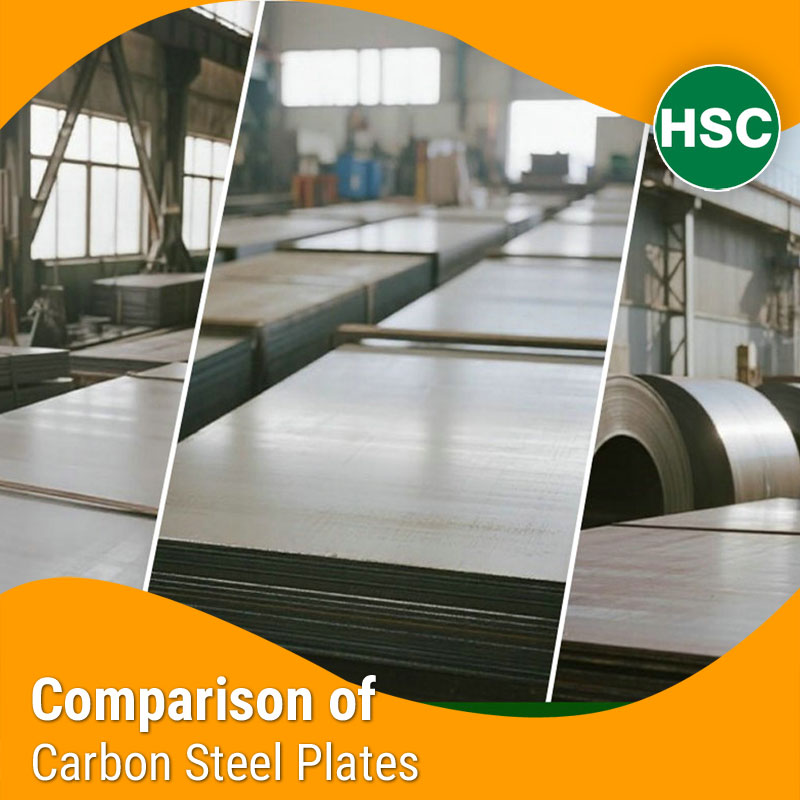Understanding the Difference Between Low, Medium, and High Carbon Steel
If you’re in fabrication, manufacturing, or project procurement, you’ve probably asked:
“What’s the real difference between low, medium, and high carbon steel plates?”
Here’s a clear, buyer-friendly guide breaking down the differences in carbon content, mechanical properties, applications, and cost.
What is Low Carbon Steel?
Carbon Content: Up to 0.30%
Common Grades:
- ASTM A36
- IS 2062 Grade B
- EN 10025 S275
Features:
- Excellent weldability
- High ductility
- Good formability
- Lower strength compared to high carbon steels
Applications:
- Structural frames
- Bridges
- Storage tanks
- General fabrication
What is Medium Carbon Steel?
Carbon Content: 0.30% to 0.60%
Common Grades:
- Some special IS/EN grades
- Machinery plates
- Certain ASTM grades for OEMs
Features:
- Higher strength
- Moderate ductility
- Needs pre-heating for welding in thicker sections
Applications:
- Heavy-duty machinery parts
- Rail tracks
- Gears and crankshafts
- Pressure parts in industrial equipment
What is High Carbon Steel?
Carbon Content: Above 0.60%
Common Grades:
- Rare in plate form
- Mostly used in tool steel, knives, wear parts
Features:
- Very high hardness
- Low ductility
- Difficult to weld
Applications:
- Cutting tools
- Wear parts
- Blades
- Springs
Note: High carbon steel plates are rare in commercial structural plate stock.
Carbon Content Range by Popular Standards
| Standard | Carbon Range |
|---|---|
| ASTM A36 | Max 0.25% |
| IS 2062 Grade B | Max 0.22% |
| ASTM A516 Gr 70 | Max 0.27% |
| EN 10025 S355 | Max 0.23% |
| High Carbon Tool Steel | Above 0.60% |
Most industrial plates fall into the low to medium carbon category.
Mechanical Properties Comparison
| Property | Low Carbon | Medium Carbon | High Carbon |
|---|---|---|---|
| Strength | Low to Moderate | High | Very High |
| Ductility | High | Moderate | Low |
| Weldability | Excellent | Moderate | Poor |
| Toughness | Good | Moderate | Low |
Weldability & Fabrication Behavior
Low Carbon Steel:
- Easy to weld
- Minimal risk of cracking
- No pre-heat needed
Common Plate Grades Stocked by Hindustan Steel Corporation
Low Carbon Grades:
- ASTM A36
- IS 2062 A/B/C
- S275JR
Medium Carbon Grades:
- Custom grades (available on request for OEM projects)
High Carbon Plates:
- Rare, supplied only for special OEM orders.
Price Difference Between Low, Medium & High Carbon Steel
Low Carbon Plates: Most economical
Medium Carbon Plates: 10–20% higher than low carbon
High Carbon Plates: Expensive, mostly custom orders
We provide a price vs performance chart on request.
Export Availability for All Carbon Steel Types
We export low and medium carbon steel plates to:
- UAE
- Saudi Arabia
- South Africa
- Vietnam
- USA
- Qatar
CIF, FOB, and Ex-Works delivery options
Buyer Tip: How to Choose Between Low, Medium & High Carbon Steel
For structural & fabrication: Go for low carbon (A36, IS 2062)
For pressure vessels: Choose medium carbon (A516 Gr 70)
For wear parts or tools: Go for high carbon (special order)
Always match material grade to application requirement and client spec.
Certifications and Test Reports
Supplied with:
- MTC with full chemical composition
- Spectro test report showing actual carbon percentage
- Third-party inspection (SGS, TUV, Lloyd’s)
FAQs – Low vs Medium vs High Carbon Steel
What is the carbon percentage in low carbon steel?
Up to 0.30%.
What defines medium carbon steel?
0.30% to 0.60% carbon content.
Can I use medium carbon steel for pressure vessels?
Yes, A516 Gr 70 is an example.
Which is easier to weld – low or high carbon steel?
Low carbon steel is easiest.
Do you stock high carbon steel plates?
Only on special order
Which steel has better ductility: low or medium carbon?
Low carbon steel.
What are examples of high carbon steel?
Tool steels, blades, springs.
Which is better for fabrication: low or medium carbon?
Low carbon for easy fabrication
What is the cost difference between low and medium carbon steel?
Medium carbon is about 10–20% costlier
Can I get impact-tested medium carbon steel?
Yes, A516 Gr 70 with CVN test.
Where can I get a carbon content chart for steel plates?
WhatsApp, Email, or Call us for a PDF.
Contact Hindustan Steel Corporation today.
Ask for:
- Carbon content-wise grade comparison PD
- Thickness-wise stock list
- Fast quote with best delivery terms

